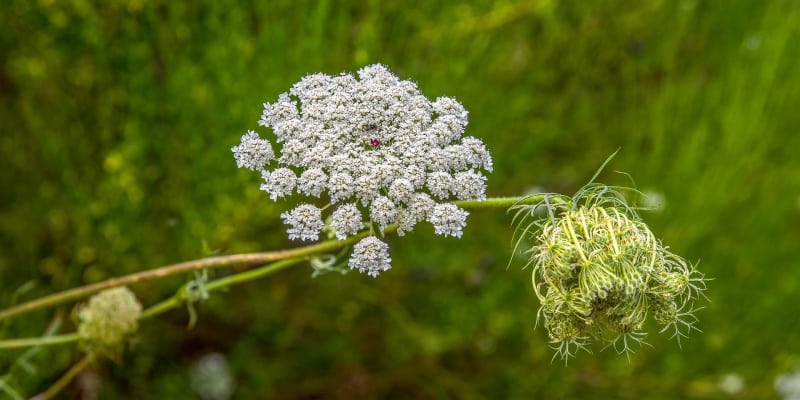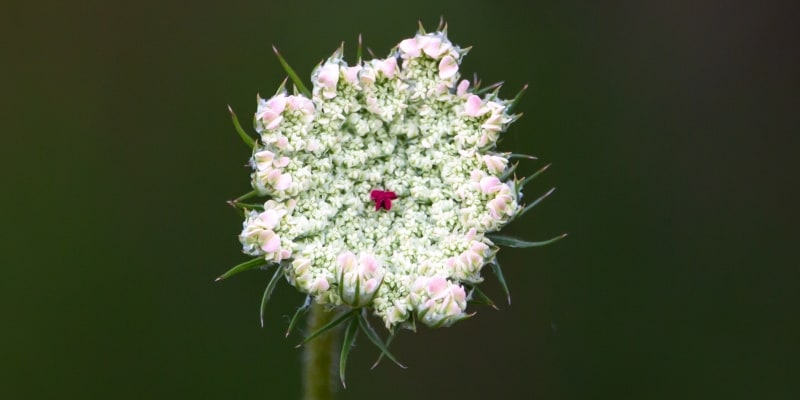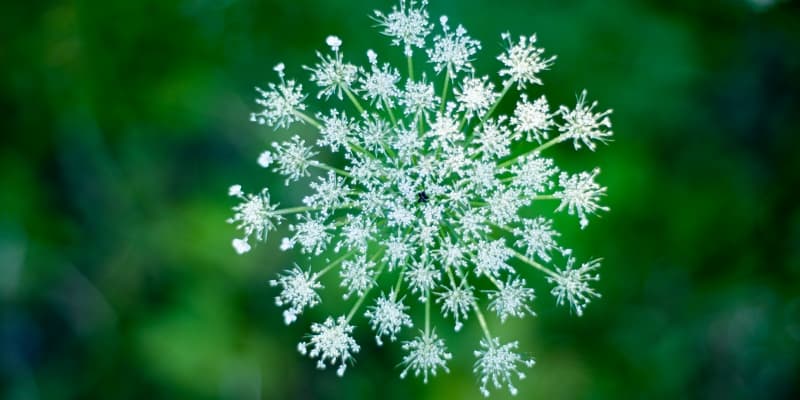Flower Glossary is reader-supported. When you buy through links on our site, we may earn an affiliate commission.
Daucus carota is a white flowering plant that forms part of the Apiaceae family of aromatic flowering plants that includes 3700+ species. It is commonly referred to as the celery, carrot, or parsley family. But, you may know Daucus carota as wild carrot, Queen Anne’s Lace, bishop’s lace, bee’s nest, bird’s nest, and devil’s plague.
This wildflower herb is common in many parts of the USA but originally comes from Europe. It was introduced in Northern America as a medicinal herb that treated urinary tract infections, gout, diarrhea, ingestion, and more.

Table of Contents
A Concise Guide to Daucus Carota
Daucus carota is a very prolific plant that is actually considered to be invasive and seen as a weed in many parts of the United States.
The herb can grow quite tall and regularly reaches heights of between one and four feet. It has fern-like leaves and graceful stems that hold a cluster of small white flowers in a flattened arrangement. There is one dark-tinged floret just off the flower’s center that is said to be the origin of its nickname ‘Queen Anne’s Lace’.
Queen Anne was a monarch of England and a celebrated lace maker. The fable goes that she pricked her finger with a needle one day, and a drop of blood stained her lace with a purple spot. This creation then ultimately turned into the well-known herb with its fascinating little purple marker in the midst of white.
On the other hand, the name ‘wild carrot’ refers to the fact that the roots of the plant were often used as a substitute for domestic carrots, even though it can be very fibrous and tough. Just like cultivated carrots, the root can become too woody to eat as it matures.
DID YOU KNOW? Freshly-cut Queen Anne’s lace flowers will turn the color of the water in which you put it in. This makes it very popular in grade-school science experiments!

How to Grow Daucus Carota
The wild carrot is a biennial that comes into bloom during its second year from spring on into fall. Growing it is quite simple and very rewarding – you just need to keep it in check.
Although it looks lovely in a home garden and adds a whimsical touch of wildflower aesthetic, it can quickly take over. As such, home gardeners should always check with their county extension office to find out whether it is considered to be invasive in their area before introducing it.
The plant is very adaptable to most soil types and pH levels and can grow in full sun, as well as partial shade. It’s this adaptability that accounts for the fact that it is so widespread and tends to spring up by itself along the roadside, in old fields, and abandoned lots.
You can purchase the plants ready-cultivated at certain nurseries, but you can also just gather some seeds from plants in the wild during fall. It will do exceptionally well in well-drained soil that is neutral to alkaline. Aside from a little watering at the height of summer, wild carrot doesn’t require much tending.
The best way to keep it within bounds is to provide a barrier, like a fence or some form of buffer plant, and to deadhead the flowers before the seeds can disperse. ‘Deadheading’ is a gardening term that refers to the removal of faded or dead flowers from plants that continue to bloom throughout the growing season.

Daucus Carota vs Poison Hemlock
Queen Anne’s Lace looks very similar to Conium maculatum, or poison hemlock, a deadly plant that can kill you if you eat its carrot-like roots. The taproot of the Daucus carota is quite tasty when you eat it as a vegetable or use it in a soup. But, there have been many instances over the years where people confused the two plants and accidentally poisoned themselves.
As such, the best rule of thumb is to avoid the roots completely if you’re not sure whether you’re dealing with poison hemlock or wild carrot. However, there are also a few simple ways to tell them apart. Poison hemlock smells bad, whereas wild carrot smells just like carrots. The former also has a smooth stem, whereas Daucus carota is hairy to the touch.
TAKE NOTE: Handling Daucus carota can lead to skin irritation in people with very sensitive skin. If you keep horses, the animals could also show skin reactions when grazing or walking among the flowers. As such, it’s best to wear gloves when tending and handling the plant.
Final Thoughts
Although Daucus carota may be an invasive plant and is a weed in certain areas, the flowers are lovely and can add some beautiful texture to home gardens and herbal arrangements. It is easy to grow but you need to keep it in check or you’ll find your garden overflowing with these plants!
